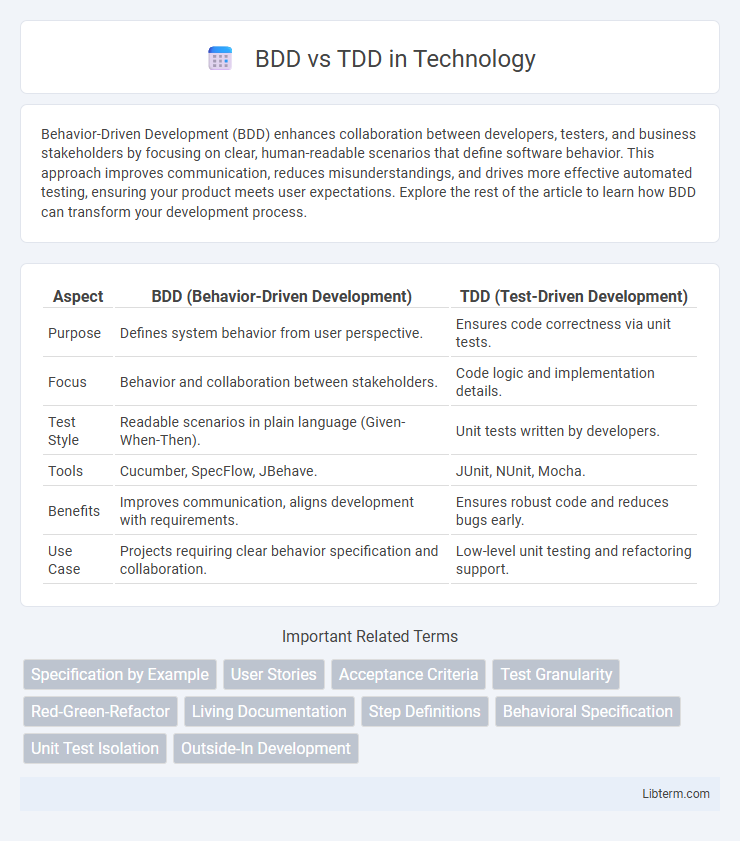Behavior-Driven Development (BDD) enhances collaboration between developers, testers, and business stakeholders by focusing on clear, human-readable scenarios that define software behavior. This approach improves communication, reduces misunderstandings, and drives more effective automated testing, ensuring your product meets user expectations. Explore the rest of the article to learn how BDD can transform your development process.
Table of Comparison
| Aspect | BDD (Behavior-Driven Development) | TDD (Test-Driven Development) |
|---|---|---|
| Purpose | Defines system behavior from user perspective. | Ensures code correctness via unit tests. |
| Focus | Behavior and collaboration between stakeholders. | Code logic and implementation details. |
| Test Style | Readable scenarios in plain language (Given-When-Then). | Unit tests written by developers. |
| Tools | Cucumber, SpecFlow, JBehave. | JUnit, NUnit, Mocha. |
| Benefits | Improves communication, aligns development with requirements. | Ensures robust code and reduces bugs early. |
| Use Case | Projects requiring clear behavior specification and collaboration. | Low-level unit testing and refactoring support. |
Introduction to BDD and TDD
Behavior-Driven Development (BDD) enhances Test-Driven Development (TDD) by emphasizing collaboration among developers, testers, and business stakeholders through shared examples and clear user-centric scenarios. TDD focuses on writing unit tests before code to ensure functionality aligns with specified requirements, helping developers create more reliable and maintainable software. Both methodologies aim to improve software quality but BDD bridges the communication gap by using natural language descriptions that define expected system behavior.
Key Definitions: What is BDD? What is TDD?
Behavior-Driven Development (BDD) is a software development approach that emphasizes collaboration between developers, testers, and business stakeholders to create shared understanding through examples and natural language scenarios. Test-Driven Development (TDD) is a programming practice where developers write test cases before writing the actual code, ensuring code functionality is verified continuously during development. BDD extends TDD by focusing on the desired behavior of an application from the end-user's perspective, using human-readable descriptions to guide testing and development.
Core Principles of BDD
Behavior-Driven Development (BDD) centers on defining application behavior through examples in a shared language, fostering collaboration between developers, testers, and business stakeholders. Core principles of BDD emphasize writing human-readable scenarios using the Given-When-Then format to specify system behavior clearly and ensure alignment with business goals. This approach enhances communication, reduces ambiguity, and drives development through executable specifications that serve as living documentation.
Core Principles of TDD
Test-Driven Development (TDD) centers on writing automated tests before code to drive software design and ensure functionality. The core principles include writing a failing test first, implementing minimal code to pass the test, and then refactoring for optimization without changing behavior. This cycle promotes high code quality, reduces bugs, and improves maintainability by focusing on incremental development and continuous feedback.
Workflow Differences Between BDD and TDD
Behavior-Driven Development (BDD) focuses on defining application behavior through collaborative scenarios written in natural language, enabling clear communication between developers, testers, and stakeholders. Test-Driven Development (TDD) centers on writing unit tests before code implementation, emphasizing code correctness and design through incremental test cases. BDD workflows typically start with user stories and acceptance criteria that guide behavior specifications, while TDD workflows revolve around writing tests to drive coding at a granular, function-level approach.
Advantages of BDD
Behavior-Driven Development (BDD) enhances collaboration between developers, testers, and business stakeholders by using clear, domain-specific language that improves communication and reduces misunderstandings. BDD's focus on user behavior and acceptance criteria promotes higher test coverage and ensures the software meets real-world requirements more accurately than Test-Driven Development (TDD). This approach also facilitates automated acceptance testing, leading to faster feedback cycles and more reliable, maintainable code.
Advantages of TDD
Test-Driven Development (TDD) offers the advantage of producing cleaner, more reliable code by ensuring tests are written before implementation, reducing bugs early in the development cycle. Developers benefit from immediate feedback, which streamlines debugging and enhances code maintainability. The disciplined approach of TDD often leads to better design decisions and higher software quality compared to Behavior-Driven Development (BDD).
BDD vs TDD: Major Similarities and Differences
Behavior-Driven Development (BDD) and Test-Driven Development (TDD) both emphasize writing tests before code to improve software quality and guide development. BDD extends TDD by incorporating natural language descriptions and collaboration between developers, testers, and business stakeholders to ensure requirements alignment, focusing on behavior and user experience. TDD centers on unit tests to drive code implementation, while BDD uses scenarios and examples to specify application behavior at a higher abstraction level.
Choosing the Right Approach for Your Project
Choosing between BDD (Behavior-Driven Development) and TDD (Test-Driven Development) depends on the project's complexity and stakeholder involvement. BDD emphasizes collaboration through human-readable scenarios that align development with business goals, ideal for projects requiring clear communication among developers, testers, and non-technical stakeholders. TDD focuses on writing unit tests before code, promoting robust, maintainable codebases in projects where technical precision and refactoring are priorities.
Conclusion: BDD or TDD – Which to Choose?
Behavior-Driven Development (BDD) emphasizes collaboration and clarity by defining tests in natural language that reflect user stories, making it ideal for projects requiring strong communication between developers, testers, and business stakeholders. Test-Driven Development (TDD) focuses on writing low-level, code-centric tests before implementation, promoting robust code quality and rapid feedback in development cycles. Choosing between BDD and TDD depends on project needs: BDD suits scenarios prioritizing business-driven requirements and communication, while TDD excels in enforcing code correctness and driving design from unit tests.
BDD Infographic

 libterm.com
libterm.com